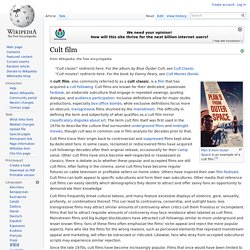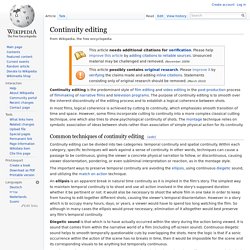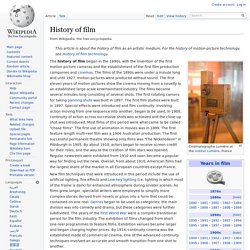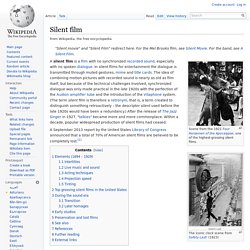

Body horror. Body horror, biological horror, organic horror or venereal horror is horror fiction in which the horror is principally derived from the graphic destruction or degeneration of the body.[1] Such works may deal with disease, decay, parasitism, mutilation, or mutation.

Other types of body horror include unnatural movements, or the anatomically incorrect placement of limbs to create 'monsters' out of human body parts. David Cronenberg, Frank Henenlotter, Brian Yuzna, Stuart Gordon, Lloyd Kaufman, and Clive Barker are notable directors of this genre. §Notable films and television series[edit] §Notable graphic novels[edit] §Use in video games[edit] In recent years the subjects of human experimentation, medical research, and infection have played large roles in video games whose plots are heavily influenced by themes common in body horror. Cult film. "Cult classic" redirects here.

For the album by Blue Öyster Cult, see Cult Classic. Cult films frequently break cultural taboos, and many feature excessive displays of violence, gore, sexuality, profanity, or combinations thereof. This can lead to controversy, censorship, and outright bans; less transgressive films may attract similar amounts of controversy when critics call them frivolous or incompetent. Films that fail to attract requisite amounts of controversy may face resistance when labeled as cult films. Mainstream films and big budget blockbusters have attracted cult followings similar to more underground and lesser known films; fans of these films often emphasize the films' niche appeal and reject the more popular aspects.
Exploitation film. Hyperlink cinema. Analysis[edit] The hyperlink cinema narrative and story structure can be compared to social science's spatial analysis.

As described by Edward Soja and Costis Hadjimichalis spatial analysis examines the "'horizontal experience' of human life, the spatial dimension of individual behavior and social relations, as opposed to the 'vertical experience' of history, tradition, and biography. "[6] English critic John Berger notes for the novel that "it is scarcely any longer possible to tell a straight story sequentially unfolding in time" for "we are too aware of what is continually traversing the story line laterally.
Continuity editing. Continuity editing is the predominant style of film editing and video editing in the post-production process of filmmaking of narrative films and television programs.

The purpose of continuity editing is to smooth over the inherent discontinuity of the editing process and to establish a logical coherence between shots. Common techniques of continuity editing[edit] Continuity editing can be divided into two categories: temporal continuity and spatial continuity. Within each category, specific techniques will work against a sense of continuity. Category:Film theory. History of film. This article is about the history of film as an artistic medium.

For the history of motion-picture technology, see History of film technology. New film techniques that were introduced in this period include the use of artificial lighting, fire effects and Low-key lighting (i.e. lighting in which most of the frame is dark) for enhanced atmosphere during sinister scenes. As films grew longer, specialist writers were employed to simplify more complex stories derived from novels or plays into a form that could be contained on one reel. Genres began to be used as categories; the main division was into comedy and drama, but these categories were further subdivided. The years of the First World War were a complex transitional period for the film industry. D. The desire for wartime propaganda created a renaissance in the film industry in Britain, with realistic war dramas. During the 1980s, audiences began increasingly watching films on their home VCRs.
Early period[edit] Histoire du cinéma. Un article de Wikipédia, l'encyclopédie libre.

Cet article retrace les grandes étapes qui jalonnent l'histoire générale du cinéma. Origines du cinéma[modifier | modifier le code] Le cinéma naît à la fin du dix-neuvième siècle. Dans de nombreux articles et livres, on peut lire encore aujourd'hui, et plus spécialement en France, que « les inventeurs du cinéma sont les frères Lumière[1] ». En fait, ils ont mis au point et fait construire une machine permettant d'enregistrer et de projeter des vues photographiques en mouvement, qu'ils ont baptisée le Cinématographe. En français, l'apocope de la marque déposée Cinématographe, le cinéma, va s'imposer dans le langage courant en quelques années. Silent film. A silent film is a film with no synchronized recorded sound, especially with no spoken dialogue.

In silent films for entertainment the dialogue is transmitted through muted gestures, mime and title cards. Classical Hollywood cinema. Category:History of film. The history of film or cinema has brought this mass media from its early stages as an obscure novelty to one of the most important tools of communication and entertainment in the modern world.

Film has existed since the late 19th century, and in the time since has had a broad impact on the arts, technology, and even politics. Subcategories. Category:Hollywood history and culture. From Wikipedia, the free encyclopedia The history and culture of Hollywood — and of the motion picture industry in the Greater Los Angeles Area and Southern California.

Subcategories. New Hollywood. The films they made were part of the studio system, and although these individuals were not "independent filmmakers", they introduced subject matter and styles that set them apart from the studio traditions that an earlier generation had established ca. 1920s–1950s.

New Hollywood has also been defined as a broader filmmaking movement influenced by this period, which has been called the "Hollywood renaissance". Background and overview[edit] Following the Paramount Case, which ended block booking and ownership of theater chains by film studios and the advent of television, both of which severely weakened the traditional studio system, Hollywood studios initially used spectacle to retain profitability. Technicolor developed a far more widespread use, while widescreen processes and technical improvements, such as CinemaScope, stereo sound and others, such as 3-D, were invented in order to retain the dwindling audience and compete with television. 1. 2. 3. 4. French New Wave. The New Wave (French: La Nouvelle Vague) is a blanket term coined by critics for a group of French filmmakers of the late 1950s and 1960s.
Although never a formally organized movement, the New Wave filmmakers were linked by their self-conscious rejection of the literary period pieces being made in France and written by novelists, along with their spirit of youthful iconoclasm, the desire to shoot more current social issues on location, and their intention of experimenting with the film form. "New Wave" is an example of European art cinema.[2] Many also engaged in their work with the social and political upheavals of the era, making their radical experiments with editing, visual style and narrative part of a general break with the conservative paradigm. Using portable equipment and requiring little or no set up time, the New Wave way of filmmaking presented a documentary style.
The films exhibited direct sounds on film stock that required less light. French Impressionist Cinema. French Impressionist Cinema, also referred to as the first avant-garde or narrative avant-garde, is a term applied to a group of French films and filmmakers of the 1920s. Filmmakers and films (selection)[edit] Periodization[edit] 1. Italian Futurism (cinema) Italian Futurism was a movement in film history from 1916 to 1919 influenced by Futurism.
Italian neorealism. History[edit] Italian Neorealism came about as World War II ended and Benito Mussolini's government fell, causing the Italian film industry to lose its center. Neorealism was a sign of cultural change and social progress in Italy. German Expressionism. German Expressionism refers to a number of related creative movements beginning in Germany before the First World War that reached a peak in Berlin, during the 1920s. These developments in Germany were part of a larger Expressionist movement in north and central European culture in fields such as architecture, painting and cinema. German Expressionist painting produced a great number of works, and led to Neo-expressionism. History[edit] 1910s–1930s[edit] The German Expressionist movement was largely confined to Germany due to the isolation the country experienced during World War I.
Besides the films' popularity within Germany, by 1922 the international audience had begun to appreciate German cinema, in part due to a decreasing anti-German sentiment following the end of World War I. The extreme anti-realism of Expressionism was short-lived, fading away after only a few years. Experimental film. Surrealist cinema. Surrealist cinema is a modernist approach to film theory, criticism, and production with origins in Paris in the 1920s. Related to Dada cinema, Surrealist cinema is characterised by juxtapositions, the rejection of dramatic psychology, and a frequent use of shocking imagery. The first Surrealist film was The Seashell and the Clergyman from 1928, directed by Germaine Dulac from a screenplay by Antonin Artaud.
Other films include Un Chien Andalou and L'Age d'Or by Luis Buñuel and Salvador Dalí; Buñuel went on to direct many more films, with varying degrees of Surrealist influence. Midnight movie. Category:New Wave in cinema. Category:Movements in cinema. Film genre. In film theory, genre (/ˈʒɒnrə/ or /ˈdʒɒnrə/) refers to the method based on similarities in the narrative elements from which films are constructed. Most theories of film genre are borrowed from literary genre criticism.
Besides the basic distinction in genre between fiction and documentary (from which hybrid forms emerged founding a new genre, docufiction), film genres can be categorized in several ways. Film noir. Film noir (/fɪlm nwɑr/; French pronunciation: [film nwaʁ]) is a cinematic term used primarily to describe stylish Hollywood crime dramas, particularly those that emphasize cynical attitudes and sexual motivations.
Hollywood's classical film noir period is generally regarded as extending from the early 1940s to the late 1950s. Film noir of this era is associated with a low-key black-and-white visual style that has roots in German Expressionist cinematography. Neo-noir. History[edit] The term film noir (French for "black film") was coined by critic Nino Frank in 1946, but was rarely used by film makers, critics or fans until several decades later. Western (genre) The Lone Ranger; a famous heroic lawman who was with a cavalry of six Texas Rangers, until they were all killed but him.
He preferred to remain anonymous, so he resigned and built a sixth grave that supposedly held his body. Spaghetti Western. These movies were originally released in Italian, but as most of the films featured multilingual casts and sound was post-synched, most "western all'italiana" do not have an official dominant language.[3] The typical Spaghetti Western team was made up of an Italian director, Italo-Spanish[4] technical staff, and a cast of Italian, Spanish, German and American actors, sometimes a fading Hollywood star and sometimes a rising one like the young Clint Eastwood in three of Sergio Leone's films.
Over six hundred European Westerns were made between 1960 and 1980.[5] The best-known Spaghetti Westerns were directed by Sergio Leone and scored by Ennio Morricone: the "Dollars Trilogy": A Fistful of Dollars (1964), For a Few Dollars More (1965), and The Good, the Bad and the Ugly (1966). Category:Film genres. World cinema. Most vibrant cinemas around the world based on IMDb. Over 10,000 titles (green), over 5,000 (yellow), over 1,000 (blue) World cinema is a term used primarily in English language speaking countries to refer to the films and film industries of non-English speaking countries. It is therefore often used interchangeably with the term foreign film. Cinema of the United States. The cinema of the United States, often generally referred to as Hollywood, has had a profound effect on cinema across the world since the early 20th century.
Cinema of Japan. Cinema of Hong Kong. Cinema of China. Cinema of Korea. Cinema of Taiwan. Cinema of the Soviet Union. Cinema of Germany. List of cinema of the world. 1970s in film.